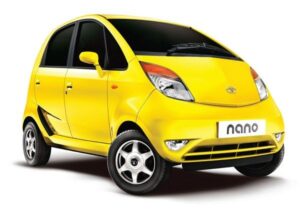The buzz around the Tata Nano EV (widely searched as “Tata Neno EV” over the last 24 hours) has again caught fire among Indian buyers looking for an affordable electric car. While Tata Motors hasn’t officially confirmed the relaunch date, rumours, patent sketches and media reports suggest that the iconic ₹1-lakh people’s car might soon return in a new electric avatar. This 1500-word blog takes a deep dive into the design leaks, expected specs, public excitement, expert reviews and how the Tata Nano EV could reshape the entry-level EV segment with a human touch.
Get the complete scoop on Tata Nano EV rumours, launch expectations, features, specs, price & early reviews as India’s most affordable electric car.
Tata Nano EV Design Leaks: Iconic Shape With a Futuristic Twist
Spy shots circulating online hint that Tata will retain the Nano’s compact egg-shaped body but add modern EV styling cues. This includes:

Closed front grille (for better aerodynamics)
LED headlamps and DRLs
Dual-tone bumpers and ORVMs
Simplified rear with H-pattern LED strip
The body is expected to stay under 3 metres, perfect for narrow Indian roads and tight parking spots. If Tata positions it smartly under the Tiago EV, it could once again be India’s most compact car.
Expected Tata Nano EV Features & Technology: Affordable Doesn’t Mean Basic
Unlike the original Nano, the EV version is expected to boast a far more upmarket cabin. Rumoured features include:
7-inch touchscreen infotainment with Bluetooth
Digital driver’s display
Power steering & power windows
Dual-tone fabric seats
4-speaker Harman sound system
Sources suggest Tata might use the same Ziptron platform seen on Tiago EV & Tigor EV but with a smaller battery to keep prices ultra-competitive.
Battery, Range & Charging: Practical Numbers for City Life
While official specs are unknown, insiders point towards a 17 kWh battery pack giving a range of 200–220 km per charge in ideal conditions. Top speed could be limited to 80 kmph to preserve battery and ensure safety. Expected charging time:
Charger Type 0–80% Estimate
Fast Charger 60 minutes
15A Plug 5–6 hours
This would make the Nano EV perfect for daily commutes, grocery runs and second-car households in urban centres like Mumbai, Delhi and Bangalore.
Tata Nano EV Price & Launch Expectation (Reviews & Market Reaction)
Analysts believe Tata Motors could price the Nano EV aggressively between ₹4.5 – ₹6.5 lakh (ex-showroom) — undercutting the MG Comet and Citroen eC3. That pricing alone has led to a frenzy on Google searches as “cheapest electric car in India” has spiked dramatically.
Early review buzz:
Automobile YouTubers and EV bloggers speculate that if Tata manages to keep prices sub-₹5 lakh, bookings could explode. A popular short review by EV-Gurus notes, “Nano EV might finally make electric mobility a middle-class reality.”
TATA NENO Ev price – Where It Fits vs Competition (MG Comet, Tiago EV, eC3)
Model Price (Start) Range Seats USP
Tata Nano EV ₹5–6 L (est) 200 km 4 Cheapest EV in India
MG Comet ₹6.98 L 230 km 4 Premium interiors
Tiago EV ₹7.99 L 250 km 5 Ziptron performance
Citroen eC3 ₹11.50 L 320 km 5 Spacious & powerful
The Nano EV’s strength will lie neither in outright range nor big features but in accessibility – something no other EV has truly delivered so far.
Real User Expectations: Humanised Reactions From Social Media
Buyers are emotionally attached to the Nano brand. Here’s what potential customers are saying online:
“If Tata brings Nano EV under 5 lakhs, I’ll book it day one. Perfect for city use,” — tweeted by @mumbaiautofan
“Hope they improve safety. Electric or not, Nano deserves a second chance,” — Facebook comment on EVInd
“Finally an EV I can think of gifting my wife without a loan,” — Reddit user
The emotional connect + practicality may turn Tata Nano EV into a disruptive product once again.
Conclusion
The idea of owning a brand-new electric car under ₹6 lakh feels like a dream — yet the Tata Nano EV might just turn it into a reality. If Tata Motors nails the pricing, offers at least 200 km range and improves the safety vs old Nano, this could redefine budget mobility for millions. From college students and retirees to urban professionals looking for a second commuter car, the Nano EV has the potential to become India’s true “people’s EV”.
Keep your eyes on Auto Expo, quarterly announcements and Nexon/Tiago EV updates – because the future of affordable EVs might arrive sooner than we think… and it might just be called Nano again.
Disclaimer:
This blog is for information and speculative purposes only. Specifications, prices and launch timelines for the Tata Nano EV are based on public rumours, early reviews and media reports. Readers should wait for official confirmation from Tata Motors before making any financial or booking decisions
REGARDS
HUDDA SUMAN
Renault Kiger: A Stylish, Spacious, and Comfortable Compact SUV Perfect for City and Highway Drives
2025 Nissan Magnite: Facelift Brings Bold Design, CNG Option and Smart Features for Everyone